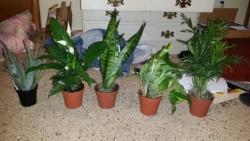It's usually a good idea to peek at the roots of anything you just bought. If they are root-bound or close to it (you can see lots of white roots, perhaps even circling the pot) If you see more roots than soil, start thinking about potting-up or re-potting.
At least move root-bound plants into bigger pots with FAST-DRAINING soilless mix. That's "potting up" and pretty easy. The mix needs to be much more coarse than garden soil, because a plant in a pot is very different from plants in the Earth. That little pot has to supply the nutrients and drainage AND AIR to the roots that would come from a much larger volume in the ground.
Soil (in the Earth) rests firmly on other soil, and drainage can occur straight down or sideways. Air can get to the roots through a large area of soil, and MANY kinds of micro and macro organisms have evolved to make plants happy.
In a pot, all they have is a few cubic inches of soilless mix, and you. If that mix doesn't drain well, it will hold enough water to displace air from the tiny voids and channels in the soil. Once filled with water, gasses like Oxygen diffuse literally 10,000 times slower than they would have if those voids had been filled filled with air as they should!
Reduced oxygen makes soil anaerobic. Roots quite literally drown - and die - and then the plant dies.
Hence, you want a coarse soilless mix in any pot. Enough water drains out, and the voids between the chunks are big enough, that much of the water exits and is replaced by air. That allows RAPID diffusion of O2 and CO2 ... keeping the roots alive, the plant healthy, and your mother happy.
If the pot comes away from the rootball cleanly, and the rootball is a solid mass of white, you might want to look up and do a "root-pruning" and soil replacement which are the key parts of a real "RE-potting".
Like, cut off the bottom inch or inch and a half of solidly overcrowded roots, and unravel or cut off the winding roots. Wash the old soil away from the remaining roots, and wiggle them into new potting soilless mix in a bugger pot.
Stores make money by doing the LEAST amount of work that will keep most of the plants barely alive, long enough to sell them. But now you've given them a good home, and they will thank and repay you for giving them what they need most: a well-drained root zone that provides room for new, small roots to form in new, clean soil.
Only new, small roots can take up minerals and water through root hairs. Those big old tough things that look like tree roots trying to strangle something, can't do much more than anchor the plant. That's why root-pruning helps the plant in the long run. As the roots grow back, the new roots are covered with healthy root hairs.
Someone more expert might suggest WHEN is a good time for re-potting. Maybe right before winter is a stressful time, and re-potting should be left for later?
